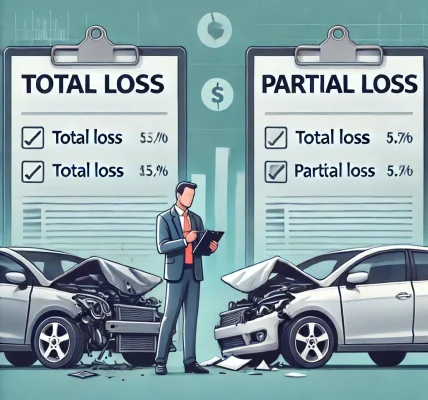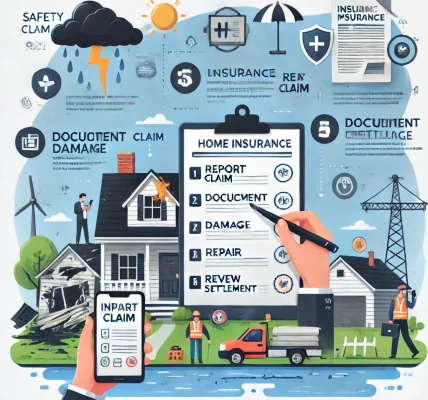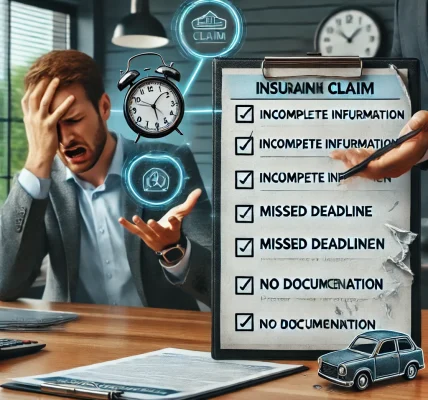Auto accidents can be stressful, and dealing with insurance claims can make the situation even more overwhelming. However, knowing how to navigate the auto insurance claim process can help you receive fair and maximum compensation for your damages.
Whether it’s a minor fender-bender or a serious collision, understanding the right steps can prevent claim denials, delays, or underpayments. This DIY guide will walk you through the process of filing a claim, avoiding mistakes, negotiating with insurers, and ensuring you get the compensation you deserve.
1. Understanding Your Auto Insurance Policy
Before filing a claim, it’s essential to know what your policy covers. Your compensation depends on the type of coverage you have.
Common Auto Insurance Coverages:
✅ Liability Coverage: Covers damages to other vehicles or people if you’re at fault.
✅ Collision Coverage: Pays for repairs to your vehicle, regardless of fault.
✅ Comprehensive Coverage: Covers non-collision damages like theft, fire, or weather-related incidents.
✅ Personal Injury Protection (PIP): Covers medical bills for you and passengers.
✅ Uninsured/Underinsured Motorist Coverage: Protects you if the other driver doesn’t have insurance.
💡 Tip: Review your policy to understand your deductibles, limits, and exclusions before filing a claim.
2. What to Do Immediately After an Auto Accident
The actions you take right after the accident can significantly impact your insurance claim.
Step 1: Ensure Safety First
- Check for injuries and call 911 if needed.
- Move your car to a safe location, if possible.
- Turn on hazard lights to alert other drivers.
Step 2: Call the Police
- A police report is crucial for your insurance claim.
- Even if it’s a minor accident, official documentation strengthens your case.
Step 3: Gather Evidence
- Take Photos & Videos: Capture vehicle damage, license plates, traffic signals, road conditions, and injuries.
- Collect Witness Information: Their statements can support your claim.
- Exchange Details with the Other Driver: Get their name, phone number, insurance details, and license plate number.
Step 4: Notify Your Insurance Company
- Report the accident as soon as possible to avoid delays.
- Provide accurate details but avoid admitting fault – let the adjusters determine liability.
💡 Tip: Use your insurer’s mobile app to file a claim faster.
3. How to File an Auto Insurance Claim
Filing a claim correctly increases your chances of getting maximum compensation.
Step 1: Contact Your Insurance Provider
- Call your insurer or file online through their portal.
- Provide accident details, police report, and damage evidence.
Step 2: Get an Estimate for Repairs
- Visit an approved repair shop or get multiple repair estimates.
- If the insurer’s offer is too low, negotiate with a counter-estimate.
Step 3: Work With an Insurance Adjuster
- Your insurer will send an adjuster to assess the damage.
- Be present during the inspection and provide all evidence.
Step 4: Negotiate Your Settlement
- If the initial offer is low, challenge it with documentation (repair estimates, medical bills, lost wages).
- Consider hiring a public adjuster if you feel your claim is undervalued.
4. Common Reasons Auto Insurance Claims Get Denied
Insurance companies look for ways to reduce payouts. Here are some common reasons why claims get denied:
❌ Delayed Reporting: Claims filed too late may be denied. Always report accidents promptly.
❌ Lack of Evidence: Insufficient photos, witness statements, or police reports can weaken your case.
❌ Policy Exclusions: Damages not covered by your policy (e.g., mechanical breakdowns) may lead to denials.
❌ Pre-Existing Damage: If the insurer suspects damage existed before the accident, they may refuse payment.
❌ Missed Premium Payments: If your policy was inactive due to non-payment, your claim will be rejected.
💡 Tip: If your claim is denied, review the denial letter carefully and file an appeal with additional supporting evidence.
5. How to Maximize Your Auto Insurance Compensation
Insurance companies often offer the lowest possible payout. Here’s how you can increase your claim amount:
✅ Provide Strong Documentation:
- Take high-quality photos and videos.
- Keep receipts for repairs, towing, and medical expenses.
✅ Get Multiple Repair Estimates:
- Compare different shops to ensure you’re getting a fair repair cost.
✅ Negotiate the Settlement Offer:
- Never accept the first offer.
- Present your own repair estimates and any additional damages.
✅ Claim All Eligible Damages:
- Include expenses for rental cars, lost wages, and medical bills.
✅ Consider Hiring a Public Adjuster:
- If the claim is large and complex, a public adjuster can help you negotiate better compensation.
💡 Tip: If the insurer offers less than expected, don’t be afraid to appeal or seek legal advice.
6. Frequently Asked Questions (FAQs)
Q1: How long does an auto insurance claim take?
It depends on the severity of the accident and the insurance provider. Simple claims can take a few days, while complex claims may take weeks or months.
Q2: Should I file a claim for minor damages?
If the repair cost is less than your deductible, it may not be worth filing a claim. However, report the accident to your insurer regardless.
Q3: What if the other driver is uninsured?
If you have Uninsured Motorist Coverage (UMC), your insurer will cover your damages. If not, you may have to sue the driver for compensation.
Q4: Will filing a claim raise my insurance rates?
In most cases, yes. If the accident is your fault, your premium may increase. However, if you’re not at fault, some insurers offer accident forgiveness to keep your rates unchanged.
Q5: Can I get compensation for a totaled car?
Yes, if your car is declared a total loss, your insurer will pay the actual cash value (ACV) minus your deductible. You can negotiate for a higher payout if the offer seems unfair.
Final Thoughts
Maximizing your auto insurance claim isn’t just about filing paperwork—it’s about knowing your rights, gathering strong evidence, and negotiating effectively.
By taking immediate action after an accident, documenting damages properly, and avoiding common mistakes, you can increase your settlement amount and ensure fair compensation.
📌 Key Takeaways:
✔️ Always report the accident and document everything.
✔️ Get multiple repair estimates and don’t accept the first offer.
✔️ Negotiate with solid evidence to get the best payout.
✔️ If denied, consider filing an appeal or consulting a public adjuster.




